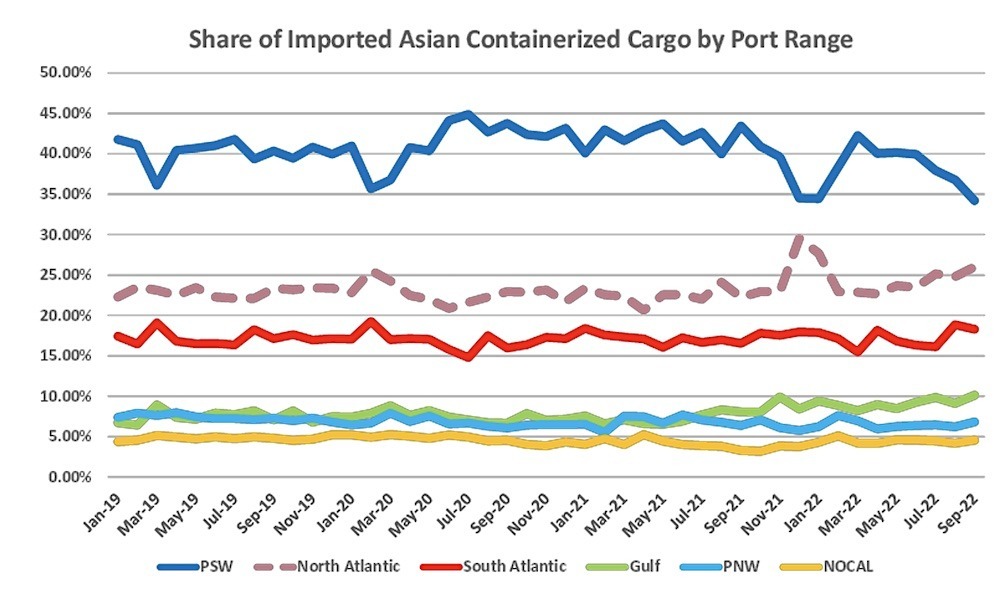Despite record volumes of cargo from Asia between 2021 and mid-2022, the 20-year decline in West Coast ports’ market share of containerized cargo accelerated late last year amid shippers’ concern about prolonged labor negotiations, according to new research by maritime economist John Martin, PhD. He concludes that the decline poses long-term economic risks, especially for Southern California.
The steady loss of containerized cargo to Atlantic and Gulf Coast ports stems from the shutdown of West Coast ports during labor talks in 2002, though several factors have contributed to the trend. Most recently, the historic congestion at the nation’s largest port complex in Southern California during the COVID-19 pandemic spurred gains for rival ports to the east.
But according to Dr. Martin’s research, the “accelerated loss of market share in the third quarter of 2022 reflects the uncertainty of the prolonged labor negotiations that have been in progress since May 2022 between the Pacific Maritime Association and the International Longshore and Warehouse Union.” He added: “It is important to note that since 2002, the West Coast ports, and in particular the San Pedro Bay Ports (Los Angeles and Long Beach), have never regained lost market share and this reversal is not likely in the foreseeable future.”

20 Years of Market Share Declines
The market share challenges have been years in the making. Since the 2002 shutdown of West Coast ports, Atlantic and Gulf Coast ports have made strategic investments to lure away so-called discretionary cargo – shipments bound for inland states, especially east of the Rocky Mountains.
They poured billions of dollars in channel and harbor-deepening projects, as well as intermodal rail projects to accommodate cargo movement to regional distribution centers. To cite just one example, the Port of New York and New Jersey spent approximately $1.6 billion to raise the Bayonne Bridge by 64 feet to allow access for larger container ships.
Dr. Martin says that these investments enable East Coast and Gulf Coast ports to offer faster and lessexpensive delivery of Asian cargo to the Midwestern state – a longtime destination for cargo handled at West Coast ports. He also cites a shift of key U.S. importers away from China to Southeast Asia, which makes the Suez Canal and a widened Panama Canal preferred trade lanes to Atlantic and Gulf Coast ports. Additionally, the growth of e-commerce has created strong demand for port-adjacent distribution centers located near major population centers, which are growing rapidly in the Northeast and Southeast U.S.
Reversing the Trend is Vital to Local Economies
While the market share losses are significant, the West Coast is still projected to see volume increases in coming years and decades. The health of regional and state economies will depend on the ability of West Coast ports to position themselves to attract future volume and compete effectively for discretionary cargo from Asia.
The Ports of Los Angeles and Long Beach are vital economic engines, supporting 23.5 percent of the California’s Gross Domestic Product and generating 233,602 direct, induced, and indirect jobs in 2021, Dr. Martin estimates. Overall import and export activity at the twin ports accounted $39 billion in direct revenue to local business providers and more than $3.4 billion in state and local tax revenue.
Discretionary cargo at the San Pedro Bay ports plays a significant role, accounting for 56,022 direct, indirect, and induced jobs, $19.3 billion in direct local business revenue, and $942.9 million in state and local taxes. Each single-percentage-point decline in discretionary cargo at the two ports would result in the loss of 5,763 direct, induced, and indirect jobs, $1.4 billion of local business revenue, and $101.2 million in state and local taxes, according to his projections.
Expanding Capacity Through Modernization and Automation
Beyond reaching a new labor contract as soon as possible and minimizing disruptions, West Coast ports must expand throughput by densifying and automating operations to remain competitive, Dr. Martin writes. “In order to avoid a continual loss of market share to the Atlantic and Gulf Coast ports, it is critical that San Pedro Bay Port Complex container terminal capacity be expanded to handle future growth, which can be accomplished through increased densification and efficiencies.”
